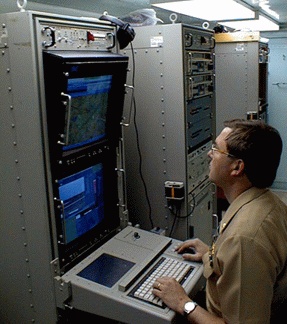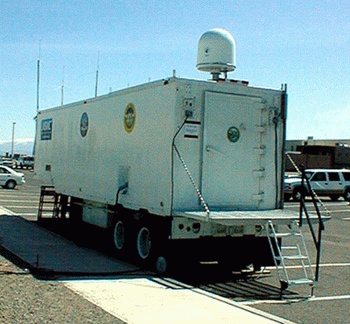




 The Tactical Control System [TCS] is the software, software-related hardware and extra ground support hardware necessary for the control of the Advanced Concept Technology Demonstration (ACTD) Outrider Tactical Unmanned Aerial Vehicle (TUAV), the RQ-1A Predator Medium Altitude Endurance (MAE) UAV and future tactical UAVs. A planned Engineering Change Proposal (ECP) will provide TCS interoperability with the RQ-2A Pioneer tactical UAV. TCS will have the objective capability of receiving Global Hawk and Dark Star High Altitude Endurance (HAE) UAV payload information. In addition, TCS incorporates the technical interfaces necessary for the dissemination of UAV imagery and data to 24 selected joint and Service C4I systems. TCS is an acquisition category II (ACAT II) program under the aegis of the Joint Project Office for UAVs (JPO-UAV).
The Tactical Control System [TCS] is the software, software-related hardware and extra ground support hardware necessary for the control of the Advanced Concept Technology Demonstration (ACTD) Outrider Tactical Unmanned Aerial Vehicle (TUAV), the RQ-1A Predator Medium Altitude Endurance (MAE) UAV and future tactical UAVs. A planned Engineering Change Proposal (ECP) will provide TCS interoperability with the RQ-2A Pioneer tactical UAV. TCS will have the objective capability of receiving Global Hawk and Dark Star High Altitude Endurance (HAE) UAV payload information. In addition, TCS incorporates the technical interfaces necessary for the dissemination of UAV imagery and data to 24 selected joint and Service C4I systems. TCS is an acquisition category II (ACAT II) program under the aegis of the Joint Project Office for UAVs (JPO-UAV).
The TCS will also provide connectivity to identified Command, Control, Communications, Computers , and Intelligence (C4I) systems. Although developed as a total package, the TCS will have the capability to be configured and down- scaled to meet the user's deployability or operator limitations.
The major focus of the TCS program is software. The software will provide the UAV operator the necessary tools for computer related communications, mission tasking, mission planning, mission execution, data processing, and data dissemination. The software will provide a high resolution, computer generated, graphics user interface that enables a UAV operator that is trained on one system to control different types of UAVs or UAV payloads with minimal additional training. The TCS will be in an open architecture and be capable of being hosted on computers that are typically supported by the using Service. The software developed will be Defense Information Infrastructure/ Common Operating Environment (DII- COE) compliant, non- proprietary, and the architectural standard for all future tactical UAVs.
For the U. S. Army and the U. S. Marine Corps, the TCS will be an integral part of the TUAV two HMMWV-based Ground Control Stations (GCSs). The Army will obtain TCSs in addition to those required for the TUAV program to receive/ control Predator UAV information. For the U. S. Navy, the TCS will initially support the TUAV and receive MAE payload data aboard L- Class Ships. The TCS will be the control system for future ship- based UAVs and UAV operations. Since ships already provide the necessary infrastructure to support a computer based system (electrical power, environmental control, radio networks, etc.), the TCS is virtually the GCS for the Navy. For the U. S. Air Force, the TCS will be an upgrade of the existing GCSs for the MAE UAV. The hardware of the TCS must be capable of being scaled or being modular to meet the varying needs of the Services. The TCS hardware will allow for long range communications from one TCS to another, data storage expansion, access to other computers to share in processing capability, and multiple external peripherals.
The advantages of a system that benefits from interoperability and commonality have been recognized since Congress directed DOD to consolidate divergent unmanned aerial vehicle (UAV) programs in 1988. Early efforts focused on the creation of a common control element operating within established standards and protocols, and interoperable with other UAV and battle management systems. The maturation of such a system was necessary to ensure the proper integration of UAVs into the existing and future battleforce structure and reduce development costs for follow-on UAV programs. The culmination of these efforts produced the UAV Tactical Control System (TCS) concept. The UAV TCS software is Defense Information Infrastructure/Common Operating Environment (DII/COE) compliant and operates on current Service hardware: Sun/SPARC (Air Force), CHS-II/SPARC-20 (Army/Marine Corps), and TAC-N (Navy). The standards, protocols, interfaces, and formats developed belong to the government and serve as the foundation for future UAV development. This promotes UAV system interoperability and overcomes many current limitations associated with stand-alone, �stovepipe� systems that have been notoriously incompatible with fielded battle management systems. Standard TCS interfaces to joint and Service C4I systems ensures UAV compatibility with fielded combat systems and supports connectivity to lower command echelons. TCS scaleability permits the system to function at five discrete levels of TCS-to-UAV interaction ranging from receipt and transmission of secondary imagery and data, to full control and operation of a UAV including takeoff and landing. The five levels of interaction include (each level of TCS capability incorporates the functionality of all lower levels):

